Mastering Ring Sizing: Your Ultimate Guide
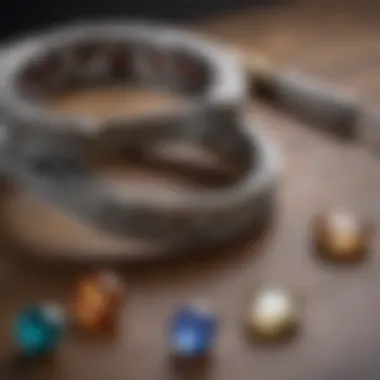
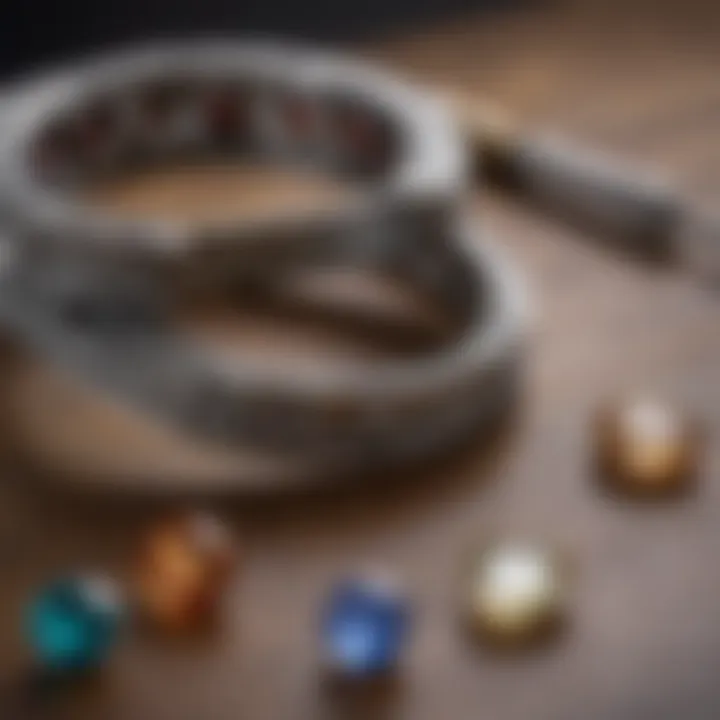
Intro
Understanding the significance of ring sizing goes beyond just aesthetics. Properly fitting a ring is crucial for both comfort and appearance. This article aims to provide an in-depth look at the components that contribute to accurate ring sizing, illustrating methods and tools that one can utilize. Furthermore, the choice of materials plays a vital role, influencing how a ring should be sized. The discussion will also encompass resizing techniques, ensuring the piece remains functional and beautiful, regardless of the circumstances.
Gemstone Overview
Definition and Characteristics
A gemstone is a piece of mineral crystal that, in cut and polished form, is considered to be a precious or semi-precious stone. Gemstones are categorized based on their optical properties, hardness, and clarity. Their color, brilliance, and overall rarity contribute to their intrigue and value. Each type of gemstone possesses unique properties that affect how it is set in jewelry, which also pertains to ring sizing.
Classification of Gemstones
Gemstones can be classified into two main categories: precious and semi-precious. Precious gemstones include diamonds, rubies, sapphires, and emeralds. These stones are typically more valuable due to their rarity and desirability. Semi-precious stones, such as amethysts, garnets, and topaz, while still beautiful, tend to be more abundant and less costly.
- Mineral Group: Gemstones can be grouped by the mineral they belong to. For instance, garnets and sapphires both have their own unique mineral compositions.
- Color and Clarity: The visual appeal of a gemstone often hinges on its color saturation and clarity. Flawless stones with vibrant colors command higher prices.
- Cut: The way a gemstone is cut can greatly affect its brilliance. A well-cut stone reflects light beautifully, enhancing its appearance.
Historical Significance
Ancient Uses and Cultural Importance
Historically, gemstones carried significant cultural weight. Ancient civilizations valued them not only for their beauty but also for their purported healing and protective properties. For example, the Egyptians adorned themselves with jewelry made from gemstones like lapis lazuli, believing in their spiritual power. Similarly, in various cultures, different gems were linked to birth months, reflecting personality traits and life paths.
Myths and Legends Surrounding Gemstones
Many myths and legends surround assorted gemstones, adding layers to their value and significance. Some believe wearing a certain gemstone can bring luck or ward off misfortune. For example, the lore of diamonds suggests they can provide strength and enhance relationships. Each gemstone often has tales that shape perceptions and guide the choices of collectors and enthusiasts.
The allure of gemstones transcends beauty, extending into spiritual realms and cultural traditions that continue to influence jewelry choices today.
Prelims to Ring Sizing
Ring sizing is a fundamental aspect in the realm of jewelry, especially for those seeking to adorn their fingers with precision-fit rings. Understanding the intricacies of sizing not only elevates the aesthetic appeal but also ensures comfort and functionality. When a ring fits well, it is less likely to slip off or pinch the skin, making the overall wearing experience pleasant. This article addresses various dimensions of ring sizing, including measurement methods, tools, and considerations surrounding material choice and finger shape.
Accurate sizing is not just a matter of preference but an essential component that influences the longevity and usability of a ring. A well-sized ring reflects the attention to detail often sought by gemstone enthusiasts, jewelry designers, and collectors. This guide aims to equip readers, whether novices or professionals, with the knowledge to navigate the complexities of ring sizing expertly. Understanding the nuances of measurement systems and the factors that influence ring size will lead to better choices in both aesthetics and comfort.
Importance of Accurate Sizing
The significance of precise ring sizing cannot be overstated. An ill-fitting ring may lead to a variety of issues; for example, too tight a fit can cause discomfort and even injury, while a loose ring may become lost. Aside from practical challenges, the emotional element attached to jewelry serves as a reminder of the importance of getting the size right. For many, a ring symbolizes a commitment, memory, or milestone.
Ensuring the accuracy of sizing plays a role in enhancing both the practicality and visual appeal of the ring. Consumers should take the extra step to verify their sizes before making a purchase, as the time and effort involved in resizing can detract from the enjoyment of the piece. In this way, a well-sized ring acts not only as a fashion statement but also as a source of pride and satisfaction.
Common Size Measurement Systems
Understanding the varying systems used for sizing rings is critical for optimizing the fitting process. Different regions employ unique measurement standards, which can sometimes lead to confusion. However, familiarity with these systems can facilitate a smoother buying experience.
US Sizing
The US sizing system employs a numerical scale that typically ranges from size 3 to size 13. Each whole and half size corresponds to a specific circumference measurement of the finger in millimeters. One significant aspect of US sizing is its widespread adoption in North America, making it more accessible for consumers in that region. This system is admired for its simplicity and clarity.
However, a downside is that the numerical size does not provide as detailed a measurement as some other systems. For example, the difference between sizes can sometimes feel negligible, yet it may be significant enough to impact comfort.
UK Sizing
UK sizing, which uses a letter-based system, is prevalent in the United Kingdom and other Commonwealth countries. Each letter corresponds to a specific measurement, and this system often includes half sizes represented by a combination of letters, such as A, B, and C. The benefit of UK sizing is its direct correspondence to finger size, allowing for an easy transition between sizes.
Nevertheless, the disadvantage arises for those unfamiliar with the letter system, given that it may not be as clear to non-UK residents. Additionally, it has limited use outside of the UK, which can complicate international purchases.
European Sizing
The European sizing system typically uses metric measurements, with sizes represented in millimeters. This system is widely recognized in various countries across Europe. One notable characteristic of European sizing is the ease with which one can convert from millimeter measurements to ring sizes, since it is directly tied to the circumference.
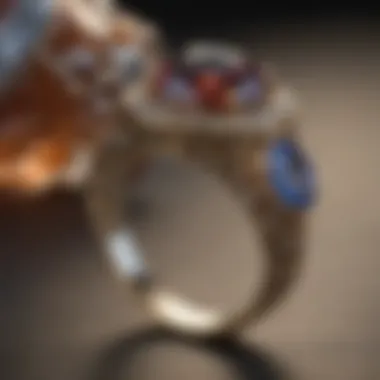
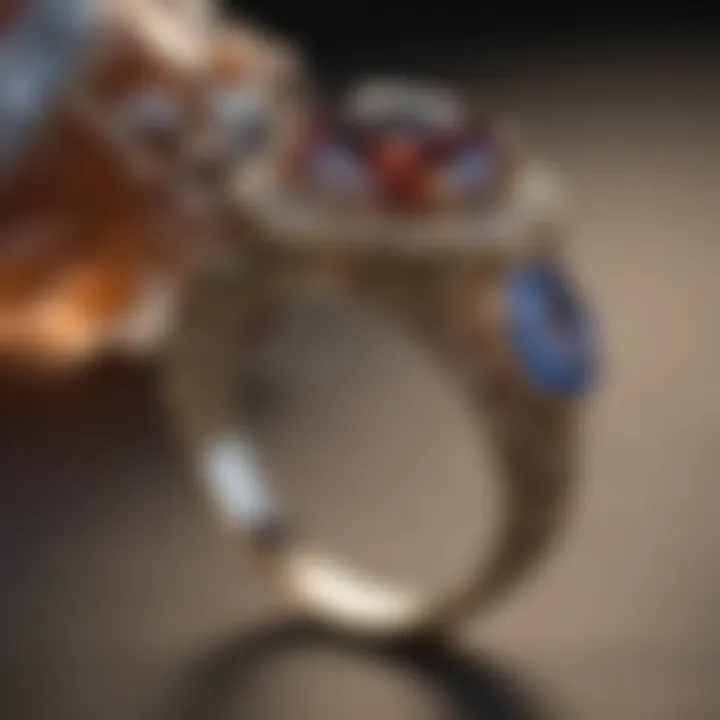
While this system is detailed and precise, the downside is that it may present challenges for those accustomed to either the US or UK systems. The lack of a universal standard can create confusion when engaged in international jewelry purchases or exchanges.
This highlights the necessity for consumers and jewelers alike to be knowledgeable about these various sizing systems. A better understanding can lead to improved fitting choices and overall satisfaction with the rings purchased.
Factors Influencing Ring Size Selection
The process of selecting the correct ring size is influenced by multiple factors that can vary significantly between individuals. Understanding these factors is crucial for ensuring a perfect fit, which can enhance both the functionality and aesthetics of the piece. The main elements to consider include finger shape variability and external conditions such as temperature and time of day. Each element provides distinct challenges and considerations that must be addressed in order to achieve an accurate sizing.
Finger Shape Variability
Finger shape plays a significant role in determining the appropriate ring size. Each person’s fingers are unique, varying in width, length, and overall shape. For instance, some individuals may have fingers that are wider at the base and taper towards the knuckle, while others have a more uniform shape. These anatomical differences can affect how a ring fits and feels on the finger.
- Wider Bases: For those with wider bases, a larger band may be necessary to accommodate the finger comfortably.
- Tapered Fingers: In contrast, individuals with tapered fingers may find that a tighter fit is more apt at the base, yet could be loose at the top.
- Knuckle Variations: Another consideration is the size of the knuckles. If there is a significant difference between the knuckle size and the base, this can complicate sizing. A ring that fits over the knuckle might slip off if it is too loose at the base.
Assessing the finger shape correctly will often involve trying on multiple rings or using a sizing tool to gauge how sizing differs across various finger types. An understanding of finger shape variability can aid not only in personal assessments but also in offering suggestions for clients in a professional jewelry setting.
Temperature and Time of Day Effects
The impact of temperature and the time of day on finger size should not be overlooked in the context of accurate ring sizing. The human body can experience fluctuations in size due to various factors:
- Temperature Variations: When temperatures rise, fingers may swell due to increased blood flow. Conversely, cooler temperatures can lead to smaller finger sizes as blood vessels constrict.
- Time of Day: It is common for fingers to swell slightly throughout the day due to activity and the body’s natural circadian rhythm. Measurements taken in the morning can differ from those taken in the evening.
To ensure the best fit, it is advisable to measure finger size during the time of day when the temperature is stable and not subject to external influences. Measuring at the same time consistently can lead to more accurate sizing results.
Important Note: Seasonality can also play a role. Warmer months may lead to increased finger size compared to winter months. This understanding is vital for collectors or jewelry enthusiasts who may want to buy pieces that require perfect sizing.
In summary, the factors influencing ring size selection extend beyond a mere measurement; they include individual anatomy and external circumstances. Recognizing these elements can help individuals select pieces that not only fit well but also maintain comfort and style over time.
Methods of Measuring Ring Size
Understanding the methods of measuring ring size is essential for ensuring an accurate fit. Whether you are purchasing a ring for someone special or adding to your jewelry collection, the precision of sizing can drastically influence overall satisfaction. An ill-fitting ring can cause discomfort, lead to potential loss, or affect the aesthetic look of the piece. Each method of measuring has its own advantages and considerations, allowing flexibility for varied situations and preferences.
Using a Ring Sizer
A ring sizer is a practical tool designed specifically for measuring ring sizes. It typically consists of a set of metal or plastic rings in various sizes. The advantage of using a ring sizer is its straightforward nature; one simply tries on the different sizes until a comfortable fit is found. This method provides direct feedback, making it easier to identify the precise size needed.
Key points to consider when using a ring sizer include:
- Variety of sizes: Ensure the sizer covers a wide range of sizes to accommodate different fingers.
- Material: Plastic sizers are great for casual use, while metal versions are more durable.
- Comfort fit: The best size is one that feels snug but can slide over the knuckle without excessive force.
By utilizing a ring sizer, you gain a tactile understanding of size, which can lead to better decision-making.
Using String or Paper Strategies
If a ring sizer is unavailable, string or paper can be utilized as an alternative method. This technique involves wrapping a strip of paper or a piece of string around the base of the finger to measure its circumference. Once marked, this length can be compared against standardized ring size charts. While this method is useful in a pinch, there are critical aspects to consider to achieve more accuracy.
- Material consistency: Use a non-elastic string or paper to avoid altering measurements.
- Correct positioning: Measure where the ring will sit, generally at the base of the finger and not too tightly.
- Temperature variable: Fingers may swell or shrink due to temperature changes, so consider measuring during cooler times.
Always allow a little extra room for comfort and any possible changes in finger size over time.
Professional Measurement Techniques
For those seeking the utmost precision, professional measurement techniques are the ideal choice. Jewelers possess specialized equipment and experience, allowing them to account for nuances that others might overlook. This service can be particularly beneficial for complex rings or for individuals who are uncertain about their exact size.
When considering professional measurement, remember these elements:
- Expertise: Jewelers can provide insights into how different styles impact fit.
- Advanced tools: Techniques may include digital calipers that measure down to decimal points for exceptional accuracy.
- Assessing for future changes: Experts can discuss how lifestyle changes, such as weight fluctuations or temperature sensitivity, may affect sizing.
In summary, employing the right method for measuring ring size is crucial. Each approach, whether using a ring sizer, string or paper, or professional assistance, comes with distinct advantages. Selecting the most suitable method depends on the available resources, desired accuracy, and personal preference.
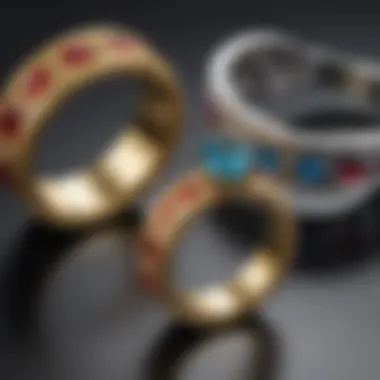
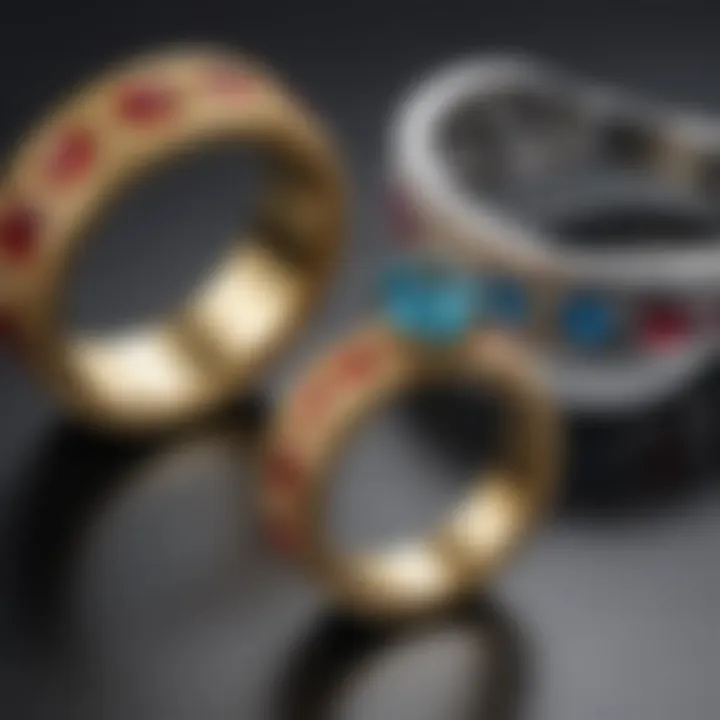
Tools and Resources for Sizing Rings
Understanding how to effectively size a ring requires the right tools and resources. Tools for sizing rings are crucial for achieving precision. They can make the difference between a perfect fit and a ring that is too loose or too tight. A proper fit enhances comfort and wearability, which are both essential factors for any jewelry piece. The following sections will focus on two important aspects: calipers and digital rulers as well as ring size charts. Each has its distinct benefits for ring measurement.
Calipers and Digital Rulers
Calipers and digital rulers are invaluable tools for measuring ring size accurately. These devices provide a precise measurement that can help avoid errors that often arise from more traditional methods. Calipers, whether manual or digital, offer a measurement system that can accommodate various shapes of rings. They can measure external dimensions and internal diameters.
Digital rulers have the added advantage of displaying measurements clearly, allowing for easy reading. They are often more user-friendly, especially for those who may not have extensive experience in measuring jewelry. The accuracy provided by these tools is essential, particularly for rings with intricate designs or uneven shapes.
When using a caliper or digital ruler, here are a few best practices to consider:
- Ensure Cleanliness: Always clean the ring before measuring. Dirt or grime can alter the measurement readings.
- Be Gentle: Apply gentle pressure. Over-tightening the calipers may push the band out of shape.
- Take Multiple Measurements: Measuring multiple times can validate your readings and ensure accuracy.
"Using precise tools for sizing can save you time and headache down the line."
Ring Size Charts
Ring size charts serve as a reference guide to match measurements with size labels across different sizing systems. These charts can be found online or in jewelry stores. Each chart displays the sizes in corresponding units for easy cross-reference.
Having a reliable ring size chart can streamline the process of determining size. It is particularly useful for those who may need to convert between different measurement systems, such as US, UK, and European sizing. Ring size charts can be consulted by following these steps:
- Measure the Inner Diameter: Use a caliper or string method to get the inner diameter in millimeters.
- Locate the Measurement on the Chart: Find the measurement on the chart to identify the corresponding ring size.
- Consider Width Variations: Wider bands may require slightly larger sizes. Always check the specific recommendations of the chart you’re using.
Collecting measurement data is only part of sizing. To achieve a perfect fit, the method of measurement should align with the type of chart used. This precision is crucial, especially when purchasing rings online or as gifts.
In summary, utilizing calipers, digital rulers, and ring size charts can greatly enhance the accuracy of ring sizing. These tools not only assist in identifying the correct size but also contribute to a more streamlined buying experience.
Challenges in Ring Sizing
When selecting a ring, understanding the challenges in sizing is essential. Rings are not just ornamental; they symbolize commitment, fashion, and personal identity. Thus, achieving the correct fit is crucial not only for comfort but also for the overall appearance.
Every individual has unique fingers. This diversity makes ring sizing complex. Additionally, various factors can lead to less than ideal measurements, creating issues later. Being aware of these challenges allows individuals to make informed decisions, minimizing errors in measurement and avoiding frustration later.
Common Mistakes in Measuring
Measuring for a ring size can seem straightforward, but several common mistakes often occur that can complicate the process.
- Using the Wrong Tools: Relying on a tape measure or string that is not calibrated can lead to inaccurate results. It is better to utilize a ring sizer or precise measuring tools.
- Ignoring Changes in Finger Size: Fingers can swell or shrink due to temperature changes, activities of the day, or even time. Neglecting these variations can lead to mis-sizing. It is wise to consider taking multiple measurements at different times.
- Overlooking the Ring Style: Different ring styles fit differently. For example, a wide band may need to be sized differently than a delicate one. Ignoring these aspects can result in a poor fit.
- Not Considering Width: Wider rings may require a slightly larger size compared to thin ones, yet this is often overlooked, leading to a mismatch between the finger proportions and the ring width.
These mistakes can result in a ring that is too tight or too loose, impacting comfort and aesthetic.
Implications of Incorrect Sizing
Incorrect sizing can lead to significant implications that are often underestimated.
- Comfort Issues: A poorly sized ring can cause discomfort. A ring that is too tight can restrict blood circulation, while one that is too loose can slide off and get lost easily. This affects daily wear and enjoyment.
- Damage Risk: An incorrect size may lead to unintended damage to the ring itself. Rings that are too tight may bend or deform, impacting the integrity of the metal. In contrast, loose rings risk scratches or other harms.
- Emotional Considerations: Rings often carry sentimental value. An ill-fitting ring can add stress, especially if it is a significant piece like an engagement ring. This emotional burden can overshadow the joy that should come with the jewelry.
- Financial Implications: Lastly, resizing a ring can incur additional costs. Whether it involves professional services or purchasing materials for a DIY approach, each error contributes to more expenses.
Understanding these implications is critical for both wearers and jewelers. Ensuring accurate sizing should always be a priority.
Resizing Options for Rings
Ring resizing is an essential aspect of ensuring that a ring fits comfortably and securely on the finger. Rings can be slightly adjusted to accommodate changes in finger size due to various factors such as weight gain, loss, or fluctuations caused by temperature. Knowing the resizing options available is crucial for anyone who is serious about maintaining the integrity and comfort of their jewelry.
Professional resizing services and DIY methods both hold distinct advantages. Each option provides varying degrees of convenience, cost, and expertise. Therefore, understanding these options allows individuals to make informed decisions based on their specific needs.
Professional Resizing Services
Seeking out professional resizing services is often the most reliable way to ensure that a ring is modified without compromising its aesthetic or structural integrity. A skilled jeweler has the experience and tools required to resize rings accurately. This process usually involves the following steps:
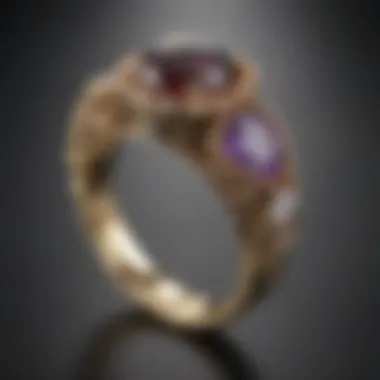
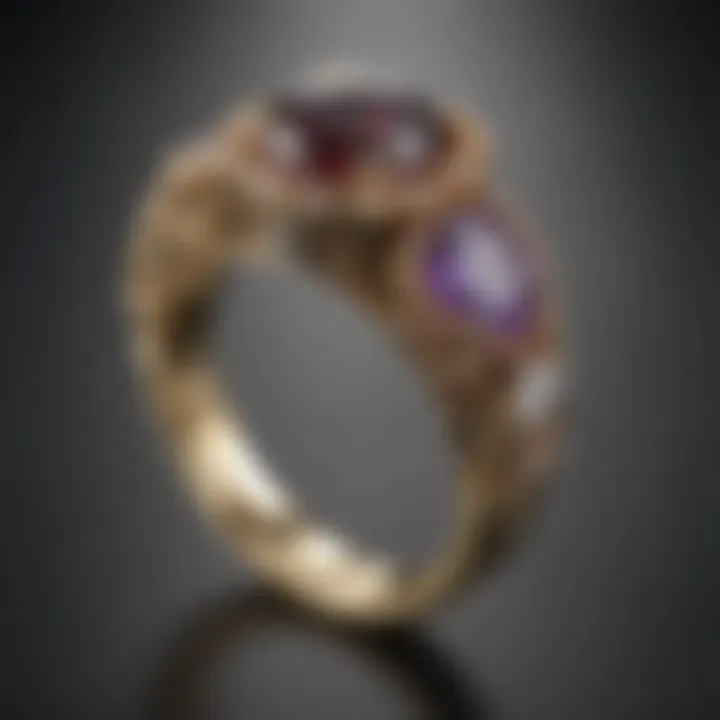
- Assessment: The jeweler will examine the ring and determine the best approach to resize it, factoring in the type of metal and any accompanying gemstones.
- Resizing Technique: Depending on whether the ring needs to be made larger or smaller, different techniques will be used. Common methods include stretching the band for larger sizes or cutting and soldering for smaller sizes.
- Polishing and Finishing: After resizing, the ring may require polishing to restore its original shine and finish. This step is crucial for preserving the appearance of the jewelry.
Benefits of professional services include precise measurements and the ability to handle complex settings. However, the downside may be the associated costs and the time involved in processing the request. Some jewelers might also require additional fees if repairs are needed aside from resizing.
DIY Resizing Methods
For those who prefer a more hands-on approach or are looking to save on costs, there are several DIY resizing methods available. While these methods may not yield the same level of precision as professional resizing, they can be practical for simple adjustments. Here are a few common DIY approaches:
- Ring Size Adjusters: These are small plastic or rubber tubes that can be added to the inside of the ring. They make the ring fit snugger, reducing its size temporarily without altering the band itself.
- Sizing Beads: These can be soldered to the band of the ring to decrease the size. While this requires basic metalworking skills, it is a less complex alternative than complete resizing.
- Temporary Solutions: Some people use tape or a strip of paper for a quick fix. This method is particularly useful for those who need to wear a ring for special occasions without long-term commitment.
While DIY resizing methods can provide immediate relief for loose-fitting rings, they also pose certain risks. Improper application may lead to damage, especially with intricate settings and gemstones. Thus, caution should be exercised.
Material Considerations in Sizing
Understanding the role of materials in ring sizing is essential for both practical and aesthetic purposes. The material from which a ring is made influences not only the comfort and fit but also the overall durability and how the size may change over time. It is vital for enthusiasts and designers to consider these factors when selecting a ring or resizing it. Here, we explore two key aspects: the impact of different gemstone settings and the properties associated with various metal types.
Impact of Different Gemstone Settings
Gemstone settings can significantly affect size measurement and the fit of a ring. Different stone types and how they are set will impact how snugly the ring sits on a finger. For instance, a ring set with a large gemstone, like a diamond, can require a larger size because these stones might increase the overall width of the band. If the stone rises high above the band, it can create more friction and less movement on the finger, potentially making the wearer feel that the ring is smaller than its actual size.
Furthermore, the setting style plays a crucial role. In a prong setting, stones are held in place by metal claws, and there is usually more space around them, leading to a different feel compared to flush settings, where the stone is embedded directly into the band. Knowledge of these nuances helps in proper sizing decisions, ensuring that the chosen size accommodates the specific gems involved.
Metal Types and Their Sizing Properties
The type of metal used in a ring can also play an essential role in sizing. Different metals have unique properties that affect their flexibility, durability, and how they respond to heat and cold. For example, gold is known for its malleability and is easier to resize. However, the karat amount can impact its strength; while 24k gold is softer and more flexible, 14k gold, comprising alloys, is more durable.
Other metals such as platinum offer superior strength and resistance to tarnishing, making them ideal for rings that are worn daily. However, because platinum is dense, it does not resize as easily as gold.
Additionally, some metals, like tungsten, are extremely hard and not ideal for resizing. Therefore, when choosing a metal, it's imperative to think about both the style and how the material will influence ring sizing in the long-term.
In summary, choosing appropriate materials affects ring sizing accuracy. The combination of gemstone settings and metal types can dictate both the aesthetic and practical aspects of ring wear. Proper consideration of these elements can lead to a better-fitting and more comfortable ring.
Maintaining Proper Fit Over Time
Maintaining the proper fit of a ring is crucial not only for comfort but also for the longevity of the piece. Over time, several changes can occur that affect how a ring sits on the finger. These changes may stem from fluctuations in body weight, temperature, or even changes in health that impact finger size. It is essential to recognize that a perfectly sized ring can become loose or tight due to these factors. Thus, regularly assessing the fit can ensure that both the aesthetic appeal and functional comfort of the jewelry is preserved.
Best Practices for Ring Care
Caring for your ring correctly is fundamental in keeping it fitting well. Here are several effective practices:
- Regular Check-ups: Schedule evaluations of your ring size, especially after significant weight changes or seasonal shifts.
- Storage Considerations: When not wearing your ring, keep it stored in a soft case to avoid scratches and deformation.
- Cleaning: Use mild soap and water for cleaning. Avoid harsh chemicals that may damage the metal or gemstones.
- Avoiding Extreme Conditions: Protect the ring from extreme heat or cold, as temperature changes can affect metal expansion and contraction.
- Professional Care: At least once a year, consult a jeweler for inspection. They can check for wear and may offer necessary resizing or maintenance.
Maintaining a proper fit can enhance the durability and look of a ring, making it a timeless part of your collection.
Implementing these best practices will help ensure that your ring continues to fit well. Rings are meant to be enjoyed and appreciated, so attending to their care can make a considerable difference in their lifetime.
End
The conclusion of this article underscores the significance of accurate ring sizing in both aesthetic appeal and comfort. A properly sized ring enhances the visual allure of the jewelry while ensuring it does not inconvenience the wearer. Understanding ring sizing is not merely an exercise in measurement; it incorporates various factors that can influence the effectiveness of a ring’s fit.
Recap of Key Points
In summary, here are the main points discussed throughout the article:
- Accurate sizing is crucial for both enjoyment and functionality of rings.
- Different systems of measurement, such as US, UK, and European sizing, cater to diverse regional preferences.
- Factors like finger shape, temperature, and time of day can impact how a ring fits.
- Various methods exist for measuring ring size, including tools like ring sizers and traditional string methods.
- The material of the ring affects how it holds its size over time.
- Resizing options, both professional and DIY, provide necessary solutions for correcting sizing errors.
Understanding these elements equips both jewelry enthusiasts and professionals with the knowledge to achieve optimal fit and comfort.
Final Thoughts on Importance of Sizing
The importance of ring sizing transcends mere aesthetics. Rings often symbolize love, commitment, and personal expression. Thus, a ring that fits poorly can detract from its meaning and suitability. Careful consideration of sizing not only bolsters the integrity of the piece but also ensures that it is worn with confidence and ease.
Proper ring sizing enriches the overall experience of wearing jewelry and fulfilling its purpose. By taking time to understand the intricacies involved in sizing, individuals can avoid future pitfalls and ensure their jewelry remains a cherished part of their lives.
"Rings symbolize connections; their fit should reflect that bond perfectly."
Each insight shared throughout this article aims to enlighten the reader on creating lasting and meaningful relationships with their jewelry through precise sizing. Investing in knowledge about ring sizing pays off in continued satisfaction and enduring beauty.







